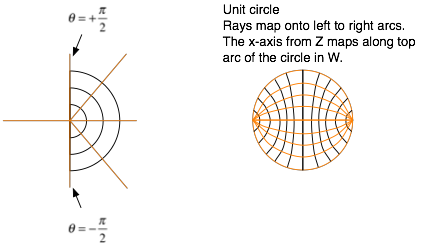Physics Notes: String
Theory
Lecture 8: Nov 8, 2010 Back to PHY32
Topics: Path Integral Issues, Conformal Mapping, Scattering
Q: In the path
integral formulation the integral is over all paths or surfaces. While the value being integrated
is simply ![]() ,
it is not clear what it means to integrate over all paths. What would the ÒdpÓ in this
integral be?
,
it is not clear what it means to integrate over all paths. What would the ÒdpÓ in this
integral be?
A: [IÕm not sure of Professor SusskindÕs exact words here so IÕm paraphrasing: ] This is a very tricky subject, beyond what can be covered in this class, and easy to g to formulate incorrectly so that path integrals donÕt converge or yield the wrong answer.
Very similar integrals came from work on random walks. These integrals are called Weiner Integrals. You can imagine a particle starting a given point making a sequence of random jumps where the probability of the jump depends on the distance. You can then ask the question, what is the probability density for the particle to arrive at a second point. If you take a limit of the number of jumps going to infinity and the expectation value of the displacements going to 0 you have a kind of integral.
These random walk integrals led to the Feynman path integral.
You can think of our strings as rubber bands in a thermal
bath. Over time the rubber
band sweeps out a trajectory in space-time. What is the probability that the rubber band goes from
state A to state B?
This type of integral must make sense, but it leads to requirements on the dimension count to avoid divergence. This is what leads to 26, 11, or 10 dimensions depending on the string description.
When we use conformal mapping to solve problems in Electro-Magnetism there is the complication that the field is really a 2-form (a rank 2 tensor). A change in coordinates yields a change in the field components. For example, an electric field will transform into a magnetic field under boost.
In the case of string theory the coordinates of a string behave like scalars and do not change under coordinate transformations.
Lecture
Conformal mappings
For Electro static problems in 2 dimensions, what is the force law and potential function?
The force is
![]()
and the potential function
![]()
Potential is a scalar, which makes it easier to work with in many cases.
The relationship is as usual:
![]()
We also know the relationship between the electric field and charge density.
![]()
Expressing in terms of ![]() we have
we have
![]()
or
![]()
As we have seen, this equation is unchanged by a conformal
mapping of the coordinates.
A bit later, we will apply the electrostatic analogy to the string
scattering problem. Before we do that we need a
better understanding of the space of conformal mappings in 2 dimensions (the ![]() space).
space).
Conformal Mappings in Two Dimensions
In two dimensions we can simplify the analysis by treating the space as the complex plane.
The mappings of interest are bijections between two regions in the complex plane.

As a first step in determining which mappings are angle preserving we need to understand some properties of derivatives of complex valued functions.
We start at point ![]() that
maps to point
that
maps to point ![]() . A displacement from
. A displacement from ![]() of
of ![]() yields a displacement of
yields a displacement of ![]() of
of ![]() .
.
Then we expect that.
![]()
But the direction of our displacement might matter. Lets start by insisting that displacements along x and y yield the same answer.
In general
![]()
Along the x-axis we have
![]()
Along the y-axis we have
![]()
And since we require that these be equal we have the two equations
![]() The Cauchy-Riemann Equations
The Cauchy-Riemann Equations
Homework: Show that requiring the derivatives to match along the x and y axes says that they match in any direction.
We can take another step and uncouple these equations taking an additional derivative
![]()
Adding these two equations and simplifying we have
![]()
Following the same process with the other derivative we also get
![]()
So the Laplace equation comes back again.
Homework: These equations imply the Cauchy-Riemann Equations. Prove this. [IÕm not sure I got this right. IÕll come back and give it a go.]
Analytic = Conformal
LetÕs write two small displacements from ![]() . We write them
in polar form because of the direct connection to angle.
. We write them
in polar form because of the direct connection to angle.
![]() and
and ![]()
If we take the ratios of the two displacements we get a complex number whose angle is the difference between the original angles.
![]()
The magnitude of this ratio is not important; all we care about is the angle.
These displacement vectors also lead to corresponding displacement vectors in the W plane.

We can compute the equivalent ratio of displacements in W
using the derivative at ![]() .
.

We rely on the derivative being the same in all directions. Since the ratios are the same in Z and W, the angle difference between the displacement vectors must be the same.
Example 1
![]()
So equating real and imaginary parts we have
![]()
We can now test this mapping with the Cauchy-Riemann Equations
![]() and
and ![]()
So this mapping is analytic and conformal.
Example 2
![]()
This gives
![]()
Testing
![]()
So complex conjugation is not conformal.
Example 3
![]()
this gives
![]()
Testing
![]() and
and ![]()
So this mapping is analytic and conformal.
Example 4
This example is important in string theory.
![]()
Where
![]() and
and ![]()
We can write w as
![]()
Then

and

ThatÕs one half of the Cauchy-Riemann equations, now for the second half

and

This checks out too.
Since this case is important for string theory, lets look at how it maps the right half plane.

Circles in Z are mapped into vertical straight lines in
W. Radial lines are
mapped to horizontal straight lines.
So the right half plane is mapped to a ribbon of width ![]() . The point a 0,0 in Z is a special point
that maps to u=-Infinity on the left and since every circle, no matter how
small in Z, maps to a line of length
. The point a 0,0 in Z is a special point
that maps to u=-Infinity on the left and since every circle, no matter how
small in Z, maps to a line of length ![]() ,
this special point can be used to represent an incoming string.
,
this special point can be used to represent an incoming string.
If you map the whole plane to W you get a wider strip, but you have to identify the top edge with the bottom edge since they represent the same set of points in Z. This generates a cylinder, which is a good mapping for a closed string.
Example 5
This case is an example of linear fractional mapping. Under linear fractional mapping circles and lines are mapped to circles and lines.
![]()

The left half of the Z plane is mapped outside of the circle.
Scattering in String Theory
Scattering behavior in string theory is nearly the
definition of string theory. We
return to the diagram of two strings joining for a time ![]() and then
breaking apart.
and then
breaking apart.

We integrate the action over all join times.
![]()
The momentum of the incoming and outgoing particles has to
be added in (integrated over). In the original diagram the incoming and
outgoing strings are at ![]() , and different ranges in
, and different ranges in ![]() .
We can use conformal mapping to map the
.
We can use conformal mapping to map the ![]() space
onto the unit circle, with the injection points on the edge of the circle. This makes the integral simpler.
space
onto the unit circle, with the injection points on the edge of the circle. This makes the integral simpler.
It turns out that under conformal mapping, we have freedom
to place n-3 of the points on the edge of the circle and the remaining three
points will be determined. [Something to investigate].
The rule for handling these special points is that we add a factor with fixed k.
![]()
to the integral.
These factors are known as vertex operators. [It looks like the conformal
mapping would have a failure – angles not preserved - at the injection
points. Perhaps this is compensation
for that failure]
Now we integrate over the positions of the insertions in the new space.
![]()
The good news is that these integrals can be done. They donÕt converge except in the right number of dimensions.
We can think of the ![]() components as independent electrostatic fields that
must separately satisfy the Laplace equation with boundary conditions. The
perpendicular E field must vanish at the edge. The charges are the components
of the momentum
components as independent electrostatic fields that
must separately satisfy the Laplace equation with boundary conditions. The
perpendicular E field must vanish at the edge. The charges are the components
of the momentum ![]() .
.
We can sum up the energy associated with the dimensions, giving an action expression, which is integrated over the injection points.
